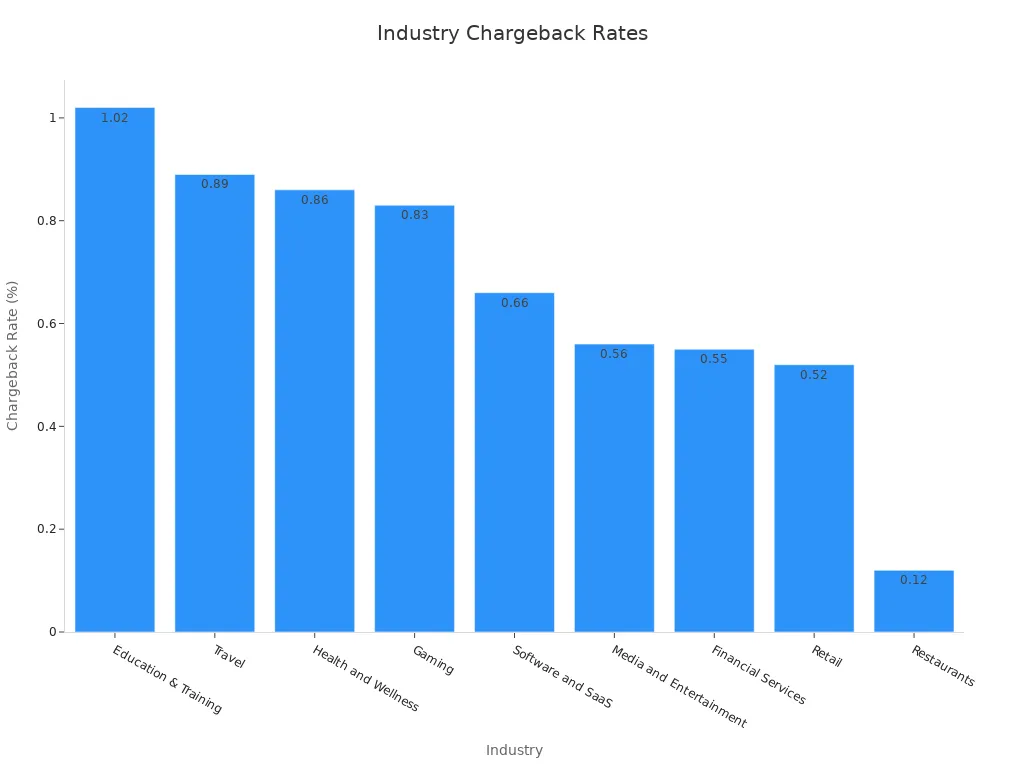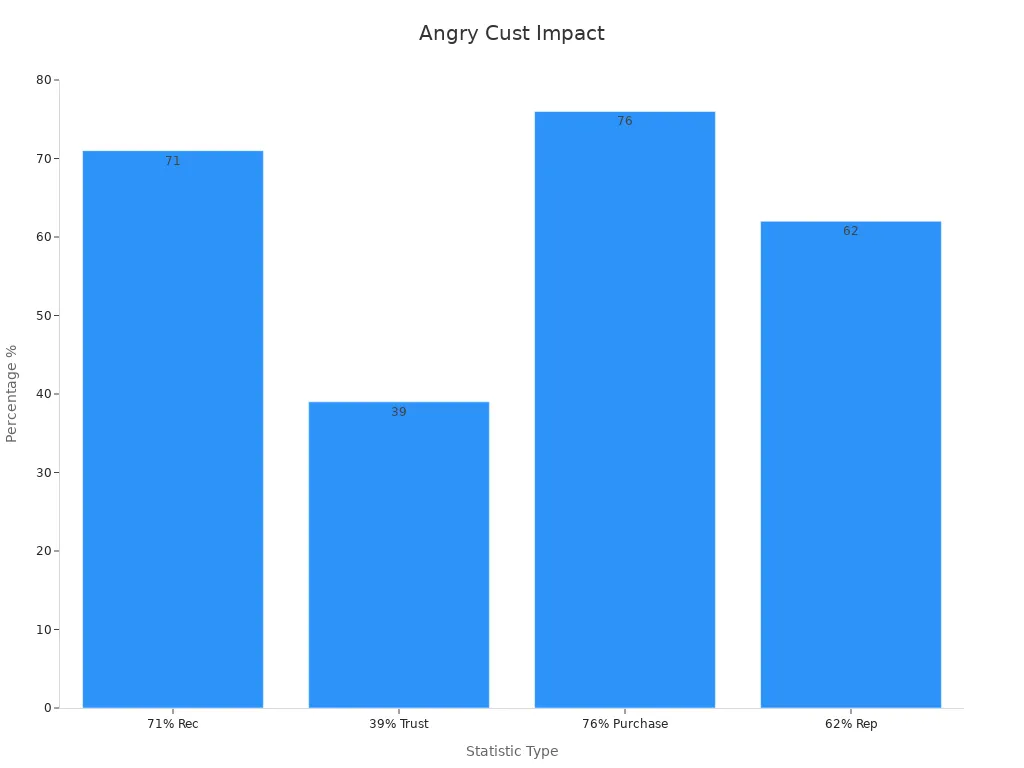Examples of How to Deal with an Angry Customer

Dealing with an angry customer can seem challenging, but it’s also an opportunity to build a stronger connection with them. Understanding how would you deal with an angry customer is key to turning their frustration into trust. By expressing empathy and showing genuine care, you can create a positive impact. Research shows that 60% of consumers are more likely to choose businesses that prioritize their needs, and active listening can increase brand loyalty by 1.5 times. Maintaining composure and focusing on effective communication are essential for improving customer satisfaction and delivering an exceptional experience. With tools like Sobot’s solutions, managing these interactions becomes seamless, ensuring every resolution leaves a lasting positive impression.
Common Angry Customer Situations and How to Address Them

Incorrect or Damaged Orders
Receiving an incorrect or damaged order can frustrate any customer. Imagine expecting a product you’ve been excited about, only to find it’s the wrong item or damaged. This is one of the most common angry customer situations businesses face. Studies show that 16% of customers stop shopping with a brand after just one incorrect delivery. That’s a significant loss for any business.
To handle this, start by acknowledging the mistake and apologizing sincerely. Let the customer know you understand their frustration. Then, offer a clear solution, like a replacement or refund, and ensure it’s processed quickly. Using tools like Sobot’s unified workspace, your team can access customer details instantly, speeding up resolutions and leaving a positive impression.
| Statistic | Impact on Customer Behavior |
|---|---|
| 16% of customers would stop shopping with a brand after receiving an incorrect delivery once. | Highlights the severity of incorrect orders on customer retention. |
Late Deliveries or Missed Deadlines
Late deliveries are another major source of complaints. Customers expect timely service, and when that expectation isn’t met, trust erodes. Did you know that 69% of consumers are less likely to shop with a retailer if an item isn’t delivered within two days? Even worse, 17% will stop shopping after just one late delivery.
To address this, keep customers informed. Proactively communicate delays and provide updates. Offering real-time tracking, like Sobot’s AI-powered voicebot, can help customers stay in the loop. This not only reduces frustration but also shows you value their time.
| Statistic | Impact on Customer Behavior |
|---|---|
| 69% of consumers are less likely to shop with a retailer if an item is not delivered within two days. | Shows the critical nature of timely deliveries for customer retention. |
| 17% will stop shopping after one late delivery. | Emphasizes the immediate consequences of delivery issues. |
Poor Customer Service Experience
A poor customer service experience can drive customers away faster than almost anything else. Nearly 78% of customers back out of deals due to bad service. Whether it’s long wait times, unhelpful responses, or rude interactions, these experiences leave a lasting negative impression.
To turn this around, focus on active listening and empathy. Let the customer vent, acknowledge their concerns, and respond with a solution. Sobot’s intelligent IVR system ensures calls are routed to the right agent quickly, reducing wait times and improving the overall experience. By addressing issues promptly and professionally, you can rebuild trust and even strengthen the relationship.
Tip: Always follow up after resolving a complaint. It shows you care and helps ensure the customer feels valued.
Billing or Payment Issues
Billing or payment problems can quickly frustrate customers. Whether it’s an unexpected charge, a failed transaction, or a confusing invoice, these issues often feel personal. Customers want clarity and fairness when it comes to their money. Did you know that industries like education and travel experience some of the highest chargeback rates?
| Industry | Chargeback Rate |
|---|---|
| Education & Training | 1.02% |
| Travel | 0.89% |
| Health and Wellness | 0.86% |
| Gaming | 0.83% |
| Software and SaaS | 0.66% |
| Media and Entertainment | 0.56% |
| Financial Services | 0.55% |
| Retail | 0.52% |
| Restaurants | 0.12% |

When dealing with billing disputes, start by listening carefully to the customer’s concerns. Acknowledge their frustration and explain the situation clearly. Transparency is key. For example, if a subscription charge was unexpected, clarify the terms and offer a resolution, like a refund or credit.
Using tools like Sobot’s unified workspace can make this process smoother. It consolidates customer data, so your team can quickly access billing histories and resolve disputes efficiently. This not only saves time but also reassures customers that you value their trust.
Tip: Always follow up after resolving a billing issue. A simple email or call can show you care and help rebuild confidence in your brand.
Unmet Expectations or Miscommunication
Unmet expectations often stem from miscommunication. Maybe a product didn’t match its description, or a service wasn’t delivered as promised. These situations can leave customers feeling disappointed or even betrayed.
Here’s the reality: 77% of consumers say a great product or service is essential for loyalty. But 70% also expect agents to have full context during interactions. When these expectations aren’t met, frustration builds.
- 4 in 10 support agents report that customers get angry when they can’t complete tasks on their own.
- 76% of customers want personalized experiences.
- 73% expect more AI-driven interactions in the future.
To address unmet expectations, focus on clear communication. If a customer feels misled, apologize and clarify what went wrong. Offer a solution that aligns with their needs. For instance, if a delivery was delayed, provide a discount or expedited shipping.
Sobot’s AI-powered voicebot can help here. It provides quick, accurate responses, ensuring customers get the information they need without long wait times. Plus, its real-time monitoring tools allow you to track interactions and identify areas for improvement.
Note: Miscommunication can damage trust, but proactive communication can rebuild it. Keep customers informed at every step to avoid surprises.
Tips for Dealing with Angry Customers Professionally
Active Listening and Letting Customers Vent
When a customer is angry, the first thing they want is to feel heard. Active listening is your best tool here. Let them express their frustration without interrupting. This simple act can make them feel acknowledged and reduce their anger. Studies show that listening patiently helps customers feel valued, which is crucial for calming the situation. In fact, even a 1% improvement in active listening can increase customer gratitude by up to 14%.
Active listening isn’t just about hearing words. It’s about understanding the emotions behind them. Nod, maintain eye contact (if in person), and use phrases like, “I understand how that could be frustrating.” These small gestures build trust. Tools like Sobot’s unified workspace can help you access customer history instantly, so you can respond with context and precision. This makes the interaction smoother and more effective.
Tip: Avoid jumping to solutions too quickly. Let the customer finish explaining their issue first.
Practicing Empathy and Understanding
Empathy is the cornerstone of dealing with angry customers. When you show that you genuinely care about their problem, it can diffuse tension almost immediately. Research highlights that empathy leads to quicker resolutions and fewer escalations. Customers are also more likely to share detailed information when they feel understood.
For example, if a customer complains about a delayed delivery, say, “I can see how this delay has caused inconvenience. Let me fix this for you.” This approach shows you’re on their side. Sobot’s AI-powered voicebot can assist by providing empathetic, real-time responses, ensuring customers feel supported even before speaking to a live agent.
Note: Empathy isn’t just about words. Your tone matters too. Keep it calm and reassuring.
Staying Calm and Using Positive Language
Staying calm is essential when dealing with angry customers. If you lose your cool, the situation can escalate quickly. Instead, focus on using positive language to steer the conversation in a constructive direction. For instance, instead of saying, “I can’t do that,” try, “Here’s what I can do to help.”
Studies show that positive language reduces customer anger by aligning with their emotional needs. It also fosters trust and makes the interaction more productive. Sobot’s intelligent IVR system can route calls to the right agent, ensuring customers don’t have to repeat themselves, which often fuels frustration.
Tip: Smile while you speak. It naturally makes your tone sound more positive, even over the phone.
Offering Clear Solutions and Reassurances
When dealing with angry customers, offering clear solutions is your best strategy. Customers want to know you’re taking their concerns seriously and working toward a resolution. If you leave them guessing, their frustration will only grow. Instead, explain the steps you’ll take to fix the issue. For example, if a product arrives damaged, tell them you’ll send a replacement immediately or issue a refund. This transparency builds trust and reassures them that you’re on their side.
Reassurances also play a big role in calming difficult customers. Simple actions like confirming timelines or providing warranties can ease their worries. For instance, letting them know their replacement will arrive within two days gives them peace of mind. Empowering your team to act quickly—like covering unexpected costs—can make a huge difference. Here’s how these strategies impact satisfaction:
| Strategy | Description |
|---|---|
| Warranties | Reassure customers that products will perform as promised, boosting trust. |
| Reassuring Communications | Post-purchase updates reduce buyer’s remorse and reinforce positive feelings. |
| Empowering Employees | Allowing immediate actions, like refunds, increases customer delight. |
Sobot’s unified workspace makes offering solutions easier. It gives your team instant access to customer data, so they can resolve issues faster. Plus, tools like Sobot’s AI-powered voicebot provide real-time updates, keeping customers informed every step of the way. These features ensure every interaction ends on a positive note.
Tip: Always use simple, direct language when explaining solutions. It helps customers feel confident in your ability to resolve their concerns.
Following Up to Ensure Customer Satisfaction
Following up is the final step in turning an angry customer into a loyal one. After resolving their issue, reach out to check if they’re satisfied. This shows you care about their experience and value their feedback. A quick email or call can make all the difference. Did you know that 68% of customers appreciate follow-ups after a complaint? It’s a simple gesture that leaves a lasting impression.
For example, if you’ve refunded a payment, send a confirmation email thanking them for their patience. If you’ve replaced a damaged product, ask if the new item met their expectations. These small actions build trust and encourage repeat business. Sobot’s call tracking feature makes follow-ups seamless. It lets your team monitor interactions and ensure every customer feels heard.
Note: Follow-ups aren’t just about resolving complaints. They’re an opportunity to learn from feedback and improve your service.
By combining clear solutions, reassurances, and follow-ups, you can turn even the most difficult customers into loyal advocates for your brand.

How Sobot's Voice/Call Center Can Help in Angry Customer Situations
Intelligent IVR for Efficient Call Routing
When a customer calls, they want their issue resolved quickly. Sobot’s Intelligent IVR (Interactive Voice Response) system makes this possible by routing calls to the right agent or department without unnecessary delays. It allows customers to specify their needs upfront, which reduces hold times and eliminates frustrating transfers. For example, if a customer needs help with billing, the IVR ensures they’re connected to a billing specialist right away.
This system also speeds up the process by authenticating customers automatically. Agents can skip time-consuming verification steps and focus on solving the problem. Outbound IVR adds another layer of efficiency by offering immediate options for common inquiries, like order tracking or account updates. These features not only save time but also improve satisfaction.
Did you know? Advanced IVR systems like Sobot’s can minimize hold times and enhance customer happiness by streamlining call routing.
Unified Workspace for Seamless Customer Interaction
Imagine having all the information you need about a customer in one place. That’s exactly what Sobot’s unified workspace offers. It consolidates customer data, call histories, and interaction details into a single, easy-to-use platform. This means agents can access everything they need to resolve issues quickly and accurately.
A unified workspace also ensures consistency. Whether a customer reaches out via phone, email, or chat, agents have a complete view of their history. This eliminates the need for customers to repeat themselves, which is a common frustration. The result? Faster resolutions and happier customers.
| Benefit | Description |
|---|---|
| Single Source of Truth | Aligns analytical efforts, ensuring consistent understanding and usage of metrics across the organization. |
| Increased Efficiency | Simplifies maintenance and monitoring of metrics, allowing for seamless updates and integration. |
| Data Integrity | Promotes data quality through a centralized framework for managing metrics. |
AI-Powered Voicebot for Quick Resolutions
Nobody likes waiting on hold. In fact, 28% of people hang up after just five minutes. That’s where Sobot’s AI-powered voicebot comes in. It handles routine inquiries autonomously, providing instant answers to common questions. This reduces the workload on human agents and ensures customers get help faster.
The voicebot’s advanced AI can even recognize intent, guiding customers to the right solution without human intervention. For example, if a customer asks about a delivery delay, the voicebot can provide real-time updates. Up to 50% of phone inquiries can shift to self-service options like this, improving efficiency and cutting down wait times.
Pro Tip: Automation tools like Sobot’s voicebot can boost agent productivity by 30%, allowing your team to focus on complex issues.
Real-Time Monitoring to Improve Service Quality
Real-time monitoring is a game-changer for improving service quality in call centers. It gives you the ability to address concerns as they happen, ensuring every customer interaction meets high standards. Imagine being able to listen in on live calls, guide a customer service agent discreetly, or even step in to resolve an issue immediately. These tools not only help you fix problems on the spot but also prevent repeated mistakes.
Here’s how real-time monitoring can elevate your operations:
| Key Features | Benefits |
|---|---|
| Live Call Monitoring | Supervisors can assess performance in real-time. |
| Instant Messaging Support | Provides discreet coaching during calls. |
| Real-time Analytics | Immediate KPI data on call performance. |
| Direct Intervention Options | Supervisors can join calls to assist agents. |
| Quick Issue Resolution | Problems can be fixed immediately. |
| Fewer Repeated Mistakes | Prevents bad habits from forming. |
| Better New Agent Support | Offers on-the-job guidance for new agents. |
| Enhanced Customer Experience | Ensures agents are well-supported. |
With Sobot’s real-time monitoring tools, you can track key performance indicators (KPIs) and provide instant feedback to your team. For example, if a customer service agent struggles with a difficult call, supervisors can step in to offer guidance. This not only boosts the agent’s confidence but also ensures the customer feels valued. Over time, this proactive approach leads to fewer complaints and a more positive customer experience.
Tip: Use real-time analytics to identify trends in customer concerns. This helps you address recurring issues and improve your service strategy.
Global Number Availability for Enhanced Accessibility
Global number availability ensures your business stays accessible to customers, no matter where they are. If you serve an international audience, this feature is essential. It allows customers to reach you through local numbers, eliminating the hassle of international dialing. This small convenience can make a big difference in how customers perceive your brand.
Sobot’s global number availability covers over 50 countries, making it easier for you to connect with customers worldwide. Whether you’re assisting a customer in Europe or Asia, they can contact your team without worrying about high call costs. This feature also supports time zone adjustments, so your customer service agents can respond promptly, even during peak hours.
For instance, if a customer in Singapore has concerns about a delayed delivery, they can call a local number and speak to an agent familiar with their time zone. This level of accessibility not only improves customer satisfaction but also strengthens your global presence.
Did you know? Businesses that offer localized support see a 20% increase in customer retention rates. Providing easy access to your team shows you care about your customers’ convenience.
Real-Life Examples of How to Deal with an Angry Customer

Apologizing for a Mistake and Offering Compensation
Mistakes happen, but how you handle them can make all the difference. Imagine a customer receives the wrong product or experiences a billing error. A sincere apology can go a long way in calming their frustration. Research shows that a genuine apology is twice as effective as simply offering compensation. For example, Chipotle’s founder publicly apologized in 61 newspapers after a food safety issue. This act of accountability helped rebuild trust with their customers.
When you apologize, keep it simple and heartfelt. Say something like, “I’m sorry for the inconvenience this has caused. Let me make it right.” Then, offer a solution. Whether it’s a refund, replacement, or discount, showing you’re willing to fix the issue builds trust. In fact, 45% of customer experience leaders believe effective apologies significantly enhance satisfaction and loyalty.
Using tools like Sobot’s unified workspace can help you resolve these situations faster. It gives your team instant access to customer details, so they can process refunds or replacements without delay. This ensures every interaction ends on a positive note.
Reassuring a Customer About a Resolution Timeline
When a customer faces an issue, uncertainty about when it’ll be resolved can add to their frustration. Communicating a clear timeline for resolution can ease their concerns. For instance, if a delivery is delayed, let them know when they can expect it to arrive. Transparency not only reduces misunderstandings but also builds trust.
Setting clear expectations from the start is key. Say, “We’re working on this and expect to have it resolved by [specific date].” Providing timely updates also helps. Studies show that keeping customers informed correlates with higher satisfaction rates.
Sobot’s AI-powered voicebot can assist by providing real-time updates on order statuses or service requests. This ensures customers stay in the loop without needing to call multiple times. By managing expectations effectively, you can turn a potentially negative experience into a positive one.
Handling a Customer Who Refuses to Calm Down
Some customers may remain upset no matter what you do. In these cases, staying calm is crucial. Let the customer vent and actively listen to their concerns. Avoid interrupting or using a blaming tone. Instead, acknowledge their frustration with phrases like, “I understand why you’re upset.”
If the situation escalates, focus on finding a solution. Ask for details about the issue and offer a resolution. For example, if a product is defective, explain how you’ll replace it or provide a refund. Avoid putting the customer on hold, as this can make them feel ignored.
Sobot’s intelligent IVR system can help by routing calls to the right agent quickly, reducing wait times. This ensures the customer feels heard and valued. Remember, even the most difficult customer examples can be resolved with patience and empathy.
Responding to Negative Feedback or Reviews
Negative feedback can feel like a setback, but it’s actually an opportunity to improve and rebuild trust. When a customer leaves a bad review, they’re giving you a chance to address their concerns and show you care. The key is to respond quickly and effectively. Did you know that 45% of customers share complaints within a day of a poor experience? Yet, only 20% receive a response within that timeframe. This gap in communication can damage trust, so acting fast is crucial.
Start by acknowledging the issue. A simple, “We’re sorry to hear about your experience,” can go a long way. Then, offer a solution or ask for more details to resolve the problem. For example, if a customer complains about a delayed delivery, explain the reason and provide a timeline for resolution. Transparency helps rebuild confidence.
It’s also important to follow up after resolving the issue. Studies show that 57% of customers change negative feedback to positive after a satisfactory resolution. Tools like Sobot’s unified workspace make this process seamless. It consolidates customer interactions, so your team can respond promptly and track follow-ups. This ensures no complaint goes unresolved.
Tip: Always thank customers for their feedback, even if it’s negative. It shows you value their input and are committed to improving.
Turning a Complaint Into a Positive Experience
Every complaint is a chance to turn frustration into loyalty. When a customer voices dissatisfaction, they’re giving you an opportunity to make things right. Here’s the good news: 72% of customers share positive experiences with six or more people. That means resolving a complaint effectively can boost your reputation.
Start by listening carefully. Let the customer explain their issue without interruptions. Then, empathize with their frustration. For instance, if a product arrives damaged, say, “I understand how disappointing this must be. Let’s fix it right away.” Offering a clear solution, like a replacement or refund, shows you’re taking their concerns seriously.
Following up is just as important. A quick call or email to check if the customer is satisfied can leave a lasting impression. Sobot’s AI-powered voicebot can help by automating updates and follow-ups, ensuring customers feel valued every step of the way.
Here’s why this approach works:
| Statistic | Value |
|---|---|
| 1 in 3 customers will leave a brand they love after just one bad experience. | 33% |
| 92% would completely abandon a company after two or three negative interactions. | 92% |
| 73% of global customers consider customer experience when making purchase decisions. | 73% |
By addressing complaints with empathy and efficiency, you can turn a negative situation into a positive one. This not only improves customer satisfaction but also strengthens loyalty.
Note: Complaints aren’t just problems—they’re opportunities to show your commitment to excellent service.
Benefits of Effectively Managing Angry Customers
Building Customer Loyalty Through Resolution
Resolving complaints effectively can transform frustrated customers into loyal advocates. When you address issues quickly and professionally, you show customers that their concerns matter. Research from Harvard Business Review highlights that customers whose complaints are resolved within five minutes are more likely to stay loyal and even recommend your brand. This underscores the importance of swift action.
Loyalty programs also play a key role in retaining customers. By offering rewards like discounts or cashback, you encourage repeat purchases and build long-term relationships. These programs work best when combined with excellent customer service. For instance, 82% of customers stop doing business after poor service, but personalized experiences can reverse this trend.
| Evidence Type | Description |
|---|---|
| Loyalty Programs | Encourage repeat purchases through rewards like points or cashback. |
| Customer Service | 82% of customers leave due to poor service, showing the value of good care. |
| Personalization | 80% of customers prefer brands offering tailored experiences. |
By following best practices like these, you can turn even negative interactions into opportunities for growth.
Enhancing Brand Reputation and Trust
Your reputation depends on how well you handle customer interactions. A positive experience can lead to glowing recommendations, while a poor one can harm your brand. Statistics show that 71% of consumers are likely to recommend a brand after a positive experience. Additionally, 62% prioritize a company’s reputation when choosing products.
Social media amplifies this effect. Engaging with customers directly on platforms like Twitter or Facebook builds trust. For example, responding to complaints publicly shows transparency and accountability. Sobot’s unified workspace can help you manage these interactions seamlessly, ensuring every response aligns with your brand values.

By adopting best practices in customer management, you not only enhance trust but also attract new customers through word-of-mouth.
Gaining Insights From Customer Feedback
Customer complaints are more than just problems—they’re opportunities to improve. When you listen to feedback, you gain valuable insights into what’s working and what needs fixing. For example, complaints about product quality can highlight areas for improvement, leading to better offerings.
Studies emphasize the importance of gathering feedback. The final step in effective complaint management involves asking customers about their experience and using that data to refine your processes. Tools like Sobot’s real-time monitoring make this easier by tracking interactions and identifying trends.
- Complaints reveal customer pain points, helping you improve service.
- Feedback allows you to refine products and reduce future complaints.
- Listening to customers builds trust and fosters loyalty.
By treating feedback as a resource, you can continuously enhance your service and keep customers coming back.
Strengthening Team Confidence and Skills
When your team feels confident, they perform better. Handling angry customers can be stressful, but it’s also an opportunity for growth. By equipping your team with the right tools and training, you can help them tackle challenges with ease. For example, role-playing exercises can prepare agents for difficult conversations. Studies show that 87% of employees feel more confident after practicing real-life scenarios.
Providing access to customer data is another way to boost confidence. Imagine an agent dealing with a frustrated customer. If they have all the details—like past interactions and purchase history—they can resolve issues faster. Sobot’s unified workspace makes this possible. It consolidates customer information into one platform, so your team always has what they need at their fingertips.
Regular feedback also plays a big role. When you acknowledge your team’s efforts and offer constructive advice, they feel valued. This not only improves their skills but also motivates them to deliver exceptional service. Over time, these small steps can transform your team into a group of confident problem-solvers.
Tip: Celebrate small wins. Recognizing your team’s achievements, like resolving a tough customer complaint, can go a long way in building morale.
Reducing Stress in Customer Service Roles
Customer service can be demanding. Dealing with angry customers, tight deadlines, and high expectations often leads to burnout. But with the right strategies, you can create a less stressful work environment for your team.
One effective approach is automation. Tools like Sobot’s AI-powered voicebot handle repetitive tasks, such as answering FAQs or providing order updates. This reduces the workload on your agents, allowing them to focus on more complex issues. Research shows that automation can improve productivity by 30%, giving your team more breathing room.
Another way to reduce stress is by offering real-time support. Sobot’s monitoring tools let supervisors guide agents during calls, providing instant feedback and assistance. This ensures your team never feels alone when handling difficult situations.
Encouraging breaks is equally important. Short pauses between calls can help agents recharge and stay focused. A well-rested team is more likely to deliver positive customer experiences.
Note: A happy team equals happy customers. When your agents feel supported, they’re more likely to go the extra mile for your customers.
Handling an angry customer with empathy and professionalism isn’t just about solving a problem—it’s about building trust. When you listen actively and respond thoughtfully, you turn frustration into loyalty. Tools like Sobot’s Voice/Call Center make this process smoother by offering features like real-time monitoring and AI-powered voicebots. These tools help you resolve issues faster and leave a lasting positive impression. Start applying these strategies today. You’ll not only improve your customer service skills but also strengthen relationships that keep customers coming back.
FAQ
What should you do if a customer refuses to calm down?
Stay calm and let them vent. Use empathetic phrases like, “I understand why you’re upset.” Focus on finding a solution. Tools like Sobot’s intelligent IVR can route calls to the right agent quickly, reducing frustration and ensuring the customer feels heard.
Tip: Avoid interrupting. Let them express their concerns fully before responding.
How can you prevent angry customer situations?
Proactive communication is key. Keep customers informed about delays or issues. Use tools like Sobot’s AI-powered voicebot to provide real-time updates. Studies show that 76% of customers appreciate proactive service, which reduces complaints and builds trust.
Why is follow-up important after resolving a complaint?
Follow-ups show you care about the customer’s experience. A quick email or call can boost satisfaction by 68%. Sobot’s call tracking feature makes it easy to monitor interactions and ensure no complaint goes unresolved.
Note: Following up also helps you gather valuable feedback for improvement.
How does Sobot help with angry customer management?
Sobot’s unified workspace consolidates customer data, enabling faster resolutions. Its AI-powered voicebot handles routine inquiries, reducing agent workload. Real-time monitoring tools ensure high service quality. These features make managing angry customers smoother and more efficient.
What’s the best way to apologize to an angry customer?
Keep it simple and sincere. Say, “I’m sorry for the inconvenience. Let me fix this for you.” Research shows that a genuine apology is twice as effective as compensation. Sobot’s tools help you resolve issues quickly, ensuring your apology feels meaningful.
Example: “We’re sorry for the delay. Your replacement will arrive tomorrow.”
See Also
Enhancing Customer Satisfaction Through Effective Live Chat Strategies
Effective Strategies for Managing Your Live Chat Team
Achieving Excellence in Live Chat Customer Support